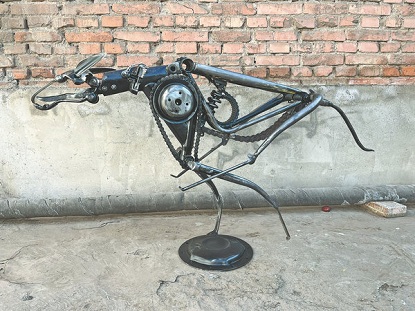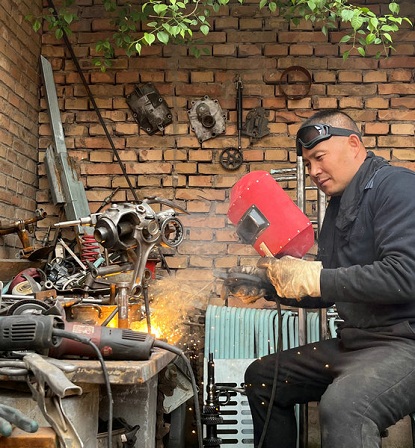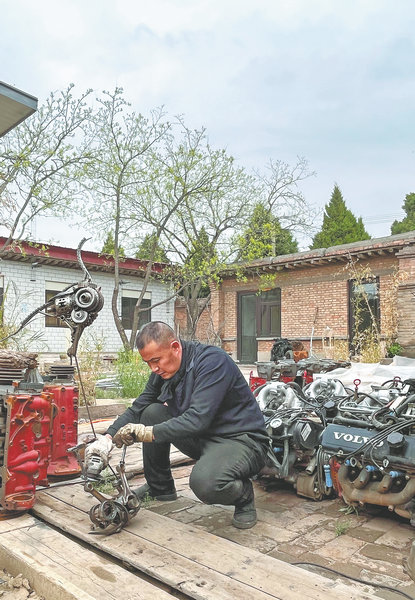Turning scrap into works of art
Updated: 2023-05-22

Li Zhi's sculpture of a dog is primarily made of discarded bike parts from a recycling center. [Photo provided to China Daily]
Childhood passion to make things out of discarded items paves the way for a creative career, report Xing Wen and Sun Ruisheng.
In the late 1970s, every time the bell rang, Li Zhi, 7, couldn't wait to dart out of the classroom with his backpack. He made a beeline for the three garbage dumps that were situated respectively in the east, west, and north of his village in Taiyuan, Shanxi province.
For Li, these were no ordinary trash heaps, but his treasure troves. He would pick up discarded items including metal barrels, rubber hoses, screws, bicycle chains, and old clocks.
"During festivals, the villagers would dispose of many household items, making it a prime time for scavenging. That was when I dug deep into the garbage to reap a bountiful harvest," recalls Li, 51.
He transformed these seemingly worthless items into raw materials of limitless potential, carefully sorting and storing them in seven special drawers in his home.
In those days of scarcity, employing a child's ingenuity, he used those materials to make his own toys — models of cars and weapons, and anything else his fertile imagination could conjure up.

Li Zhi has a passion for turning trash into treasure and has become a master artisan in Taiyuan. [Photo provided to China Daily]
As years passed, that young boy with a knack for turning trash into treasure has become a master artisan. Li is renowned throughout his community for creating exquisite sculptures out of these metal scraps he has salvaged from these junkyards near his studio.
Recently, his series of 12 zodiac animal sculptures made from discarded metal earned him the gold prize at a cultural and creative design competition held in Taiyuan.
Inspired by traditional Chinese paintings, in which artists use a freehand brush technique to convey a feeling or impression, rather than representing an exact likeness of the subject, Li captures the spirit and essence of the animals, rather than striving for an exact physical representation, in his artworks.
"When designing and creating these sculptures, if I ever got stuck or had some free time, I would often wander around nearby junkyards, waiting for a small discarded item to spark new inspiration," he says.
For instance, before creating the final version of the rabbit sculpture, he had already made two previous, unsatisfactory attempts.
But one day, while wandering around in a junkyard, he picked up a small, curved metal sheet and had the sudden inspiration to use it for the rabbit's upper mouth, which added a vivid touch to the sculpture.

Li Zhi has a passion for turning trash into treasure and has become a master artisan in Taiyuan. [Photo provided to China Daily]
Apart from scavenging for raw materials in junkyards and recycling centers, most of the materials used in the sculptures were sourced from scrapped car engines.
Nearly a decade ago, he purchased nearly 200 obsolete car engines.
"Parts of these engines are exquisite industrial products, and the original intention of collecting them was to use them as materials for creating artworks," he says.
Currently, about one-third of the engines have been dismantled and used for his creations.
When he was younger, he enjoyed riding motorcycles, so he has made more than 100 model motorcycles using the engine parts.
He has a passion for an industrial aesthetics and seeks to use his craft to give new life to discarded industrial products.
"In this fast-paced world, what we have in abundance is waste," he says.
His sculptures of a dog and a monkey are primarily made of discarded bike parts from a recycling center.

Li Zhi's sculptures of zodiac animals, including (from left) the rabbit, goat, dragon, rooster and snake, are made from discarded metal and have earned him the gold prize at a cultural and creative design competition held in Taiyuan, Shanxi province. [Photo provided to China Daily]
He hopes to promote environmental awareness through his works and inspire other artists or students to see the potential of seemingly useless materials in creating art.
Li's series of animal statues has won praise from viewers and experts.
"This series of artworks depicts the 12 zodiac animals and, despite the common subject, it exhibits extraordinary expressiveness and gives a fresh visual presentation to the traditional theme," Shanxi-based writer Jie Ziping comments.
"The symbolism of the 12 zodiac animals is deeply ingrained in our culture. They represent the passage of time and the cyclical nature of life, while also symbolizing resilience and continuous growth. I eagerly anticipate Li's next series of artworks. I'm sure it will present a fresh and distinctive perspective."
Li is also interested in the traditional furniture-making techniques in Shanxi, which is also a national-level intangible cultural heritage.
He enjoys collecting antique furniture and is captivated by the rough texture of northern China's elm wood.
In a future project, he hopes to blend innovative ideas with traditional home-furnishing techniques to create handmade furniture with wider market appeal.
Contact the writers at xingwen@chinadaily.com.cn



